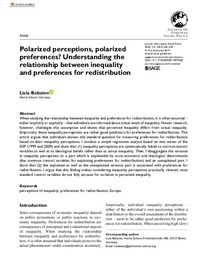Polarized perceptions, polarized preferences? Understanding the relationship between inequality and preferences for redistribution

Journal of European Social Policy
2020
30
2
May
206-224
income redistribution ; social inequality ; public opinion
Income distribution
https://doi.org/10.1177%2F0958928719879282
English
Bibliogr.
"When studying the relationship between inequality and preferences for redistribution, it is often assumed – either implicitly or explicitly – that individuals are informed about actual levels of inequality. Newer research, however, challenges this assumption and shows that perceived inequality differs from actual inequality. Empirically, these inequality perceptions are rather good predictors for preferences for redistribution. This article argues that individuals answer the standard question for measuring preferences for redistribution based on their inequality perceptions. I conduct a simple regression analysis based on two waves of the ISSP (1999 and 2009) and show that (1) inequality perceptions are systematically linked to socio-economic variables as well as to ideological beliefs rather than to actual inequality. Then, I disaggregate the variance in inequality perceptions to a part which is explainable by socio-economic and ideological determinants (the common control variables for explaining preferences for redistribution) and an unexplained part. I show that (2) the explained as well as the unexplained variance part is associated with preferences for redistribution. I argue that this finding makes considering inequality perceptions practically relevant since standard control variables do not fully account for variation in perceived inequality."
Digital
The ETUI is co-funded by the European Union. Views and opinions expressed are however those of the author(s) only and do not necessarily reflect those of the European Union or the ETUI.